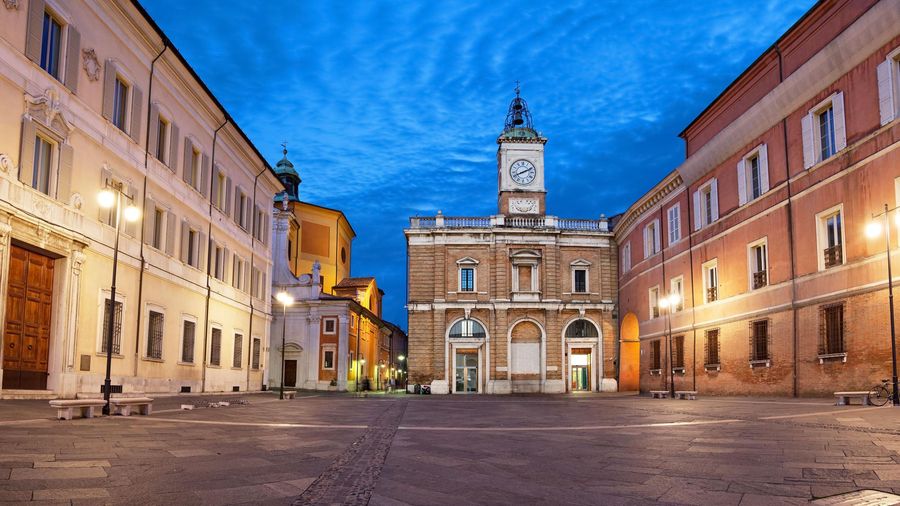
Ravenna
Ravenna, located in the Emilia-Romagna region of Italy, is a city steeped in history, art, and culture. Known as the "City of Mosaics," Ravenna was once the capital of the Western Roman Empire and is home to some of the most stunning and well-preserved Byzantine mosaics in the world. This small yet vibrant city offers a journey through time, where visitors can explore its magnificent churches, ancient monuments, and artistic masterpieces. Ravenna’s unique blend of Roman and Byzantine heritage makes it a must-visit destination for travelers seeking to uncover Italy’s rich historical and artistic legacy.
A City Steeped in Historical Significance
Ravenna’s historical significance is unparalleled. In the 5th century, it became the capital of the Western Roman Empire, playing a pivotal role in shaping the course of European history. Later, under Byzantine rule in the 6th century, Ravenna became a cultural and religious hub, serving as a bridge between the Western Roman and Eastern Byzantine empires. This era of prosperity is reflected in the city’s dazzling mosaics, which adorned the walls of its churches and palaces.
Over the centuries, Ravenna continued to flourish as a center of art, religion, and trade. Its religious monuments, many of which are UNESCO World Heritage Sites, are a testament to the city’s importance as a crossroads of cultures. Today, Ravenna remains a city of historical and artistic significance, drawing visitors from around the world to admire its ancient treasures.
Top 5 Unique Characteristics of Ravenna
1. The Byzantine Mosaics
The most defining feature of Ravenna is its breathtaking collection of Byzantine mosaics. These mosaics, found in several of the city’s churches, are considered some of the finest in the world. The mosaics date back to the 5th and 6th centuries and depict biblical scenes, saints, and emperors in vivid detail, with intricate patterns of gold, blue, and green. Among the most famous sites are the Basilica of San Vitale, the Mausoleum of Galla Placidia, and the Basilica of Sant'Apollinare Nuovo, all of which showcase the stunning craftsmanship of early Christian art.
2. UNESCO World Heritage Sites
Ravenna boasts eight UNESCO World Heritage Sites, making it a treasure trove of history and culture. These include the Basilica of San Vitale, the Mausoleum of Theoderic, and the Neonian Baptistery, each representing a different period of Ravenna’s rich history. The blend of Roman and Byzantine architecture and art in these monuments is unmatched, offering visitors a unique opportunity to witness the fusion of Eastern and Western influences.
3. Dante’s Tomb
Ravenna is the final resting place of Dante Alighieri, the famed Italian poet and author of The Divine Comedy. After being exiled from Florence, Dante spent his final years in Ravenna, where he completed his magnum opus. Visitors can pay homage to Dante at his tomb, located in a peaceful corner of the city near the Basilica di San Francesco. Each year, the city celebrates Dante’s legacy with special events and exhibitions, making it a pilgrimage site for literature lovers.
4. Basilica di Sant'Apollinare in Classe
Just outside Ravenna lies the Basilica di Sant'Apollinare in Classe, one of the most important early Christian basilicas in Italy. This basilica is renowned for its stunning mosaics, which depict scenes of Christ and the apostles, as well as the city’s patron saint, Saint Apollinaris. The basilica’s location near the ancient port of Classe gives visitors a sense of Ravenna’s maritime past, offering both historical insight and architectural beauty.
5. The Ravenna Festival
Ravenna is not just about its ancient past—it is also a vibrant cultural city in the present day. The annual Ravenna Festival is one of Italy’s premier performing arts festivals, featuring a wide range of concerts, operas, and ballet performances. Held in the city’s historic venues, including the Teatro Alighieri, this festival brings together world-class artists and musicians to celebrate Ravenna’s artistic heritage. The festival is a major draw for visitors, showcasing the city’s ongoing contribution to the arts.
Ravenna Today: A Modern City with Ancient Roots
While Ravenna’s historical significance is undeniable, it is also a lively, modern city that balances its ancient heritage with contemporary culture. Visitors can stroll through its charming streets, visit local markets, and enjoy the region’s famous cuisine, including dishes like cappelletti and piadina romagnola. Ravenna’s coastal location also makes it a gateway to the Adriatic Sea, with nearby beaches offering a relaxing escape from the city’s historical landmarks.
Ravenna is a city that has preserved its past while embracing the present, making it a unique destination for travelers interested in both history and modern Italian life.
Fun Facts About Ravenna
Ravenna was once surrounded by the sea, but the coastline has since receded several miles inland.
The city’s mosaics inspired Gustav Klimt, a famous Austrian painter, during his “golden phase”.
The dome of the Neonian Baptistery features an intricate mosaic depicting John the Baptist baptizing Christ, surrounded by the twelve apostles.
The Mausoleum of Galla Placidia houses one of the oldest mosaics in Ravenna, showing the Good Shepherd surrounded by sheep.
Dante’s Tomb was built in the 18th century, and a flame inside the tomb is said to be kept lit by oil donated by the city of Florence as a gesture of reconciliation.
With its dazzling mosaics, rich history, and vibrant cultural scene, Ravenna is a city that leaves a lasting impression on all who visit. Whether you’re exploring its ancient monuments, paying homage to Dante, or enjoying its artistic festivals, Ravenna offers a unique and enriching experience that combines the best of Italy’s past and present.